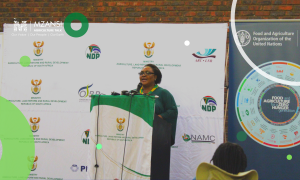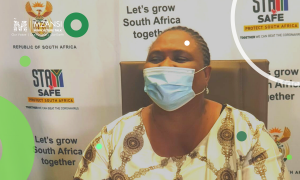By Ms Thandeka Ntshangase
Grain specialist
The South African soybean industry has undergone a period of remarkable growth and productivity. The industry has consolidated its position as an important producer and contributor to the country’s agricultural and agro-processing sectors while strengthening competitiveness within the global oilseed complex. The industry has expanded the area planted, achieved record yields, and enhanced the linkage of the livestock and soybean value chain bolstered by significant investments in the processing capacity and infrastructure development, which are the key driving factors of the 2025 production season.
The Crop Estimates Committee (CEC) forecast that 1.151 million hectares will be planted with soybeans in the 2025 season, reflecting a slight increase of 0.04 percent above the 1.150 million hectares planted in 2024. Although seemingly marginal, this increase in land area is part of a trend of consistent growth, primarily due to increased profitability and robust demand from regional processors. The eighth production estimate for the 2025 soybean crop is 2.75 million tons, unchanged from the projection from the previous month but represents a significant 48.9 percent compared to the 2024 season’s final crop. Such a substantial rise signals increased yields due to viz (i) favourable weather during the planting and growing seasons; (ii) increased demand by the market; and (iii) enhanced farming methods aided by improved technology.
The 2025–2026 supply and market outlook reflects structural improvement in the sector. According to the Supply and Demand Estimates Committee (S&DEC), total soybean supply is expected to reach 2.8 million tons, which is roughly 25% more than the final amount reported by the South Africa Grain Information Service (SAGIS) for the 2024–2025 season. At the same time, it is anticipated that total demand, that includes both exports and domestic consumption, is expected to reach 2.4 million tons, reflecting an annual increase of 12.9%. Approximately 1.965 million tons are anticipated to be crushed domestically for oil and oilcake, to serve both domestic and export markets, while 22,000 tons will be processed for human consumption, 128,000 tons are set aside for animal feed (full fat), and 10,500 tons reserved for seed. It is noteworthy that during the 2025–2026 marketing season, whole soybean exports are expected to exceed 300,000 tons, while imports are expected to drop to about 12,300 tons, equivalent to a 92 percent decline from the previous marketing year. This significant decrease in import dependency highlights robust domestic output and high stock levels, enabling South Africa to keep moving forward with its goal of increased soybean supply self-sufficiency.
[1] A detailed supply and Demand Estimates report is accessible here.
Notwithstanding these remarkable advancements, the local soybean industry continues to be confronted with several critical obstacles that could limit its long-term potential expansion. Some of the challenges confronting the industry includes viz (i) unpredictable rainfall patterns; (ii) changing temperatures levels, and (iii) frequent seasonal droughts that have a substantial impact on production output. All these factors continue to be a major risk. Profit margins are still under pressure due to the rising input costs of improved seed varieties, fertilizers, fuel, and irrigation. Making matters worse is the structural barriers related to logistics and market access are also persistent, especially due to inefficiencies in road and rail transportation, inadequate rural infrastructure maintenance, and inefficiencies at ports like Durban. Furthermore, South Africa faces intense competition in the global soybean market, where major producers like the United States (US), Brazil, and Argentina control international commerce by lowering production costs, utilizing cutting-edge technology, and establishing more effective supply chain systems.
However, several elements support the South African soybean industry’s tenacity and consistent expansion. Increasing the country’s domestic processing capacity, especially by investing in crushing plants, has enabled the nation to turn raw soybeans into oil and oilcake for both domestic and international markets, increasing the value of its production base. This approach encourages the creation of jobs in the agro-processing sector in addition to generating demand upstream. Furthermore, the expanding feed and poultry sectors have become significant sources of demand for soybean meal, hence enhancing the crop’s contribution to national food security. Productivity and sustainability are further increased by technological advancement and the use of high-yielding cultivars that are resistant to pests and drought.
South Africa continues to have a very small but growing footprint in the global soybean market. South Africa’s producers have capitalised on niche market opportunities, particularly in the European Union (EU) by producing non-GMO soybeans that align with the strict regulatory and consumer preferences for traceable non-GMO products. This strategic positioning broadens South Africa’s market reach and increases its export competitiveness.
Remarkably, South Africa has seen record-breaking harvests in recent seasons; whereby some areas yielded over 2.3 tons per hectare. Largely due to the rising domestic demand from the animal feed and oilseed processing industries, soybeans have already surpassed maize and wheat as the nation’s third most significant grain and oilseed crop. Strategic investment, technical adaptability, and policy support are all attributable to the industry’s growth and modernization trajectory.
In conclusion, South Africa’s 2025 soybean season represents a period of structural consolidation and competitive growth. The sector’s success extends beyond record-high production levels. The sector’s achievement highlights a strategic move toward improving processing efficiencies, lowering reliance on imports, promoting self-sufficiency in the oilseed value chain, whilst supporting the livestock value chain. The South African soybean industry appears to be well-positioned to maintain long-term growth and boost its competitiveness internationally if current trends, consisting of sustained investment in production and logistical infrastructure, predictable regulatory system, and enhanced market integration, continue. Consistent with the Agriculture and Agro processing Master Plan (AAMP), this trajectory highlights the nation’s ability to use agricultural innovation and value addition as important pillars of inclusive economic development and trade expansion in an increasingly competitive global market. Furthermore, this underscores soybeans’ significance as a domestic food security.
Disclaimer: The views expressed in this article is solely that of Independent Agricultural Economist Robert Matsila, and does not necessarily reflect the views of Mzansi Agriculture Talk, his employers, or other associated parties.




















